I’ve had to unblock far fewer bath drains in my time than most other bathroom facilities, but when they do block up, it usually goes one of two ways; a quick plunge and clear, test and walk away, or a bit of nightmare.
The nightmare ones tend to be because of access. Baths, especially in modern bathrooms, tend to be made to look very nice but no thought given to maintenance and future problems.
Common Bathtub blockages tend to be caused by:
- Scale Mineral Buildup: Especially in places where hard water is present, minerals can deposit and solidify in the pipes, causing blockages.
- Hair: Probably the most common culprit, hair binds with grease and other sticky substances to form clogs.
- Soap Scum: Soap residues can accumulate and harden inside pipes, narrowing them and reducing water flow.
- Dirt and Sand: While bathing or washing, sand and fine dirt can accumulate over time and settle in the drain – especially when there is very little fall or gradient in the waste pipe between the bath and main waste pipe.
- Small Objects: Small items such as bottle caps, small toys, or jewelry can accidentally fall into the drain and restrict water flow.
- Oils and Greases: Oils from bath products and natural body oils can solidify in pipes and contribute to blockages.
- Foreign Materials: Cotton swabs and other hygiene products can often find their way into a bath plughole, sometimes for a long enough period that everything else – such as hair – clings to them and ends up creating a solid mass around the object.
Signs of a Blocked Bath
Most bath blockages don’t just appear overnight, especially when compared to toilet blockages which can be fairly quick to form. Nevertheless, here are some signs your bath might be getting blocked…
Slow Draining Water
The most obvious sign of a blockage is water draining slower than usual. If it takes longer for the water to go down after your bath or if it stands in the tub, there’s likely a clog impeding the flow.
Gurgling Sounds
Unusual noises coming from your bath drain can be a sign of trapped air in the plumbing system due to a blockage. Gurgling or bubbling sounds occur when air is forced through the water in the trap as the drain struggles to pull in air from any available source.
Unpleasant Odors
Foul smells emanating from the bath drain can be caused by the buildup of bacteria and decomposing organic matter stuck in the pipes. If you notice persistent bad odors, it’s a clear indication that there is a blockage or restriction that needs to be addressed.
Water Backing Up
If you see water coming back up your drain, this is a critical sign of a severe blockage. This indicates that the water is completely unable to pass through the pipes and is being forced back up through the nearest outlet.
Changes in Flush Efficiency
If you notice that your toilet or other fixtures are not flushing correctly or exhibit unusual behavior, it could suggest that your blockage is affecting more than just your bath. This might indicate a more extensive blockage in the downstream section of the bathroom waste pipe system, or even outside in some cases.
Sometimes flushing the toilet or running the sink may cause the bath to gurgle, or vice versa – this all depends on how your bathroom is configured (more on that later).
If you notice any of these signs before your bath blocks completely, it’s probably best to deal with it there and then, before it gets worse.
Identifying Where the Blockage is
Before you get the tools out or call someone, take a step back, maybe make a coffee, and assess where the blockage is likely to be.
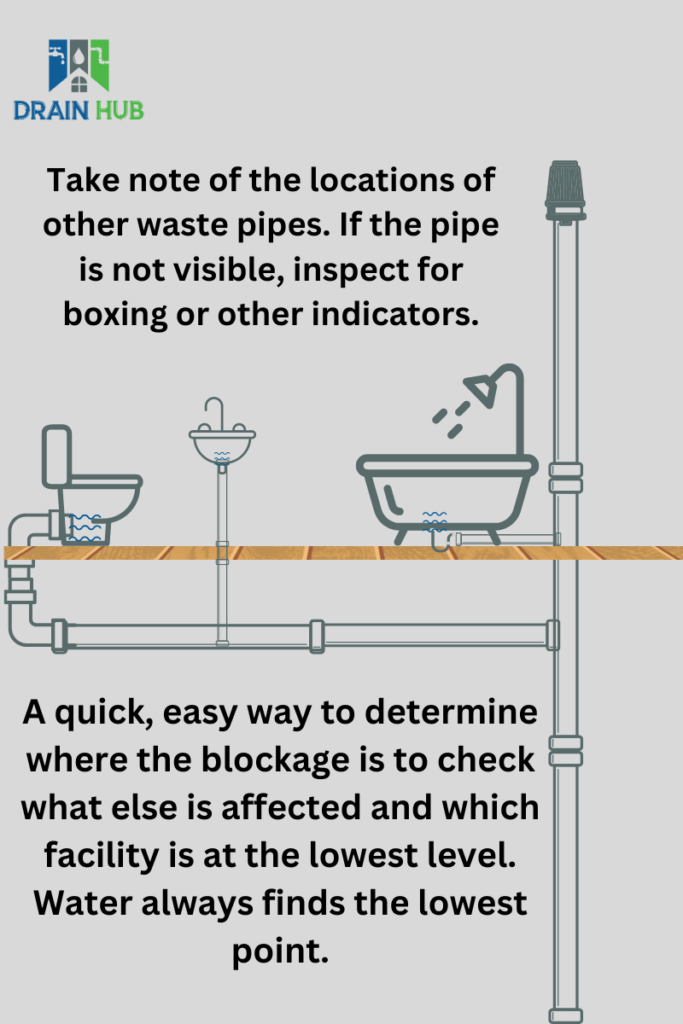
Here you can see a very simplified example of a bathroom waste pipe layout.
The first thing to take note of is, what exactly is backing up and is it the lowest water level in the room? For example, baths are usually the lowest drain in a bathroom. If you run the sink basin and flush the toilet, and these flow normally, it could just be the bath itself.
If, let’s say, you run the sink in between the toilet and the bath, and this causes the bath and to back up and the toilet to gurgle, then chances are the blockage is further along. This doesn’t necessarily mean it will be harder to clear, it just changes the method and place of attack.
If you find the blockage appears to be further along than the bath, I would suggest moving on to another section of DrainHub to clear from another angle.
If you think it’s the bath itself, however, it should be fairly straightforward and easy to clear.
Important Note!
I’ve never used chemicals to clear blockages, but I have been to enough emergency call outs where drain cleaners or unblockers were used but either not effective, or outright caused bigger problems.
I’m sure some chemical products work just fine and can be effective if used right, but baths are trickier to put right if the chemical you try does make it worse: Access
Many baths are difficult to reach around to the waste pipe or trap under plughole, and it may not be noticeable if the product eats away at a rubber or plastic seal as well as the intended blockage.
Now let’s prep to attack this blockage head-on…
The easiest but maybe not the most effective way to unblock a bath is to simply fill it with hot, soapy water and let it sit.
If you have the time to do this and the blocked bath is not an immediate issue, you can leave this for an hour or so and let the heat and soap soften the blockage as well as push against it.
If it’s the trap or U bend, this is likely to work (eventually), if it’s in the waste pipe between the bath and main waste pipe, it could still work.
Assuming this hasn’t worked, or you don’t want to wait that long, let’s continue.
Tools and Materials Needed for a Blocked Bath
In most cases, the good thing about blocked baths compared to the likes of toilets and stack pipes is you shouldn’t need that many tools and you should be able to deal with it yourself.
In some other cases, if the blockage is an awkward place or the bath waste pipe is flat before it gets to the vertical stack pipe, it may need some extra steps.
Safety and Cleaning Gear
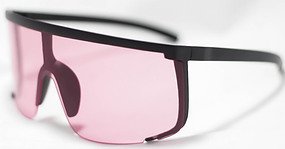
It’s boring but necessary, you should start with some PPE. If nothing else, you don’t want to get grubby hands dealing with whatever’s causing the blockage…
- Rubber Gloves: Protect your hands from dirt, germs, and chemicals with durable gloves.
- Safety Goggles: Essential to protect your eyes from splashes, especially if using chemical solutions.
- Ventilation: Ensure the area is well-ventilated, especially if you’re using chemical drain cleaners. Open windows or use a fan to circulate air and reduce fume inhalation.
It’s also a good idea to prepare a bag for disposing of the contents of the blockage, assuming you retrieve it. Throwing it away immediately is better than throwing it in the bathroom bin to stink the room out
Basic Tools
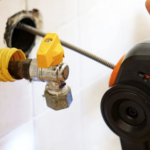
- Plunger: A plunger can create a pressure difference needed to dislodge minor blockages. Ensure you have a good-quality plunger with a strong suction capability.
- Drain Snake (or Plumber’s Snake): This tool is invaluable for reaching deeper into the drain to break up or retrieve blockages that are beyond the reach of simpler tools.
- Bucket: Handy for catching any water that may need to be bailed out from the bath before starting the unclogging process.
- Old Towels or Rags: Useful for mopping up any spills or water that escapes during the unclogging process.
Chemicals and Natural Solutions
These are viable options, and seem to be the go-to for other websites giving out drain clearance advice, but I personally have never had to use the soda and vinegar trick, and as warned at the start of this page, I strongly recommend using chemical unblockers as an absolute last resort, on the basis that they can make the problem much worse if they dissolve or weaken the rubber seals in the waste pipe joints. Especially as bath waste pipes can be a pain to get to.
But just to cover all avenues, here they are:
- Baking Soda and Vinegar: A natural alternative to chemical cleaners, this combination can help dissolve organic material causing the blockage.
- Commercial Drain Cleaner: For tougher clogs, a chemical drain cleaner may work. Use these cautiously, as they can be harsh on pipes and the environment.
Optional Tools
- Flashlight: Helps in seeing deep into the drain or under the bath panel if you need to inspect pipe connections.
- Adjustable Wrench or Grips: May be necessary if you need to loosen a pipe fitting or move other pipes out of the way.
Whichever method of attack you choose, test the bath cautiously to make sure there are no leaks, then fill the tub at least half way – ideally with hot, soapy water – and let it go. If any remains of the blockage is clinging to the pipe bends or joints, this should make sure it not only keeps moving, but the flow of water will get to the larger pipes which take the toilets and other facilities.
How to Clear your Bath
Before you attempt to unclog your bath, you should have an idea of where the blockage is by now.
If you decide the blockage is only affecting the bath and the toilet and handwash basin are unaffected, I would start with the following:
Fill the Bath a Few Inches
Most of the time when unblocking drains, you want to remove the water or wait for it to drop by itself.
But in this case, you want to use the weight of water or pressure to your advantage. The water has nowhere else to go, so the blockage will have some force exerting on it, trying to move it along.
Do not do this if your pipe work is prone to leaking, or a leak is another symptom of your blocked bath!
My go-to now would be the Rothenberger RoPump Toilet Plunger, but you may not have the budget for it or the time to wait. There are alternatives and a plain old plunger may work. Even pushing down on the plughole with your (gloved) hand may help!
Below is a video of the Rothenberger in action on a sink, the same principles apply.
To get more pressure on the blockage, you may need to cover the overflow of the bath or any vents, sometimes you need the extra oomph. An extra pair of hands could come in handy.
You can use tissue, a flannel or tea towel, or just a hand to block the overflow.
As for the plunger, you want to make a good seal between the plunger and the plughole. A purpose made plunger for this purpose, such as the Rothenberger range of plungers, makes this easy but you can clear with smaller, budget plungers.
This method clears the vast majority of bath blockages, at least in my experience.
But if this doesn’t work or you don’t want to risk the pipe leaking from excess pressure, there are other methods of attack.
Clearing the Area
- Remove Excess Water: If there’s standing water in the bath, use a bucket or cup to remove it. This will give you better access to the drain and prevent any additional mess during the unclogging process. It worked in our favour when trying the first method but will make a mess if the pipe work is opened below, so emptying it first will save time and mess.
- Clean Around the Drain: Wipe down the area around the drain. Removing any residues or debris on the surface can prevent additional material from falling into the drain during the clearing process.
Inspecting the Drain
- Check for Visible Obstructions: Often, clogs in bath drains are caused by hair and soap scum accumulations that are visible near the surface. Wear rubber gloves and carefully remove any materials you can see. This can sometimes solve the problem without further steps.
- Use a Flashlight: Shine a light down the drain to check for further obstructions that might be just inside the pipe. Removing visible blockages can significantly improve drainage and might even eliminate the need for more invasive procedures.
Manual Removal of the Blockage
If plunging doesn’t work, let’s go with the mechanical route, by hand or machine.
Hopefully you will find the blockage is within the trap or U bend, and removing it will solve the issue.
Don’t forget to wear at least gloves and safety eye wear!
Carefully remove the trap by disconnecting both the upper end which connects to the bath plughole and the bottom, downstream end which connects to the waste pipe.
It might be useful to take a photo at this point just so you have a reference. If you’ve done this before or pretty confident, don’t worry about the photos.
Keep it in the position you found it in as you carefully remove it, and dump the water/contents into a bucket or container. If it contains more solid mass than water, then BINGO – that’s your issue.
Solved by Cleaning Trap
Not solved by Cleaning Trap
Using a Drain Snake or Other Mechanical Drain Cleaner
For stubborn clogs that are beyond the reach of plungers and manual removal, a drain snake, also known as a plumber’s snake, can be a highly effective tool.
This allows you to physically reach into the pipes and either break up or retrieve blockages.
If you have a relatively straight bath waste pipe from trap to the next size up pipe, usually a stack pipe where the toilet joins, you may be able to do this with a thin, flexible cable of some sort.
Operating the Drain Snake
If the Rothenberger Ropump won’t clear an internal blockage, my next step is almost always a mechanical drain cleaner if the blockage is within a small bore (36-50mm) waste pipe. Sometimes I’ll even use it for 100mm waste pipes such as float or stack pipes, if it makes sense to do so, for example I can’t get rods down there.
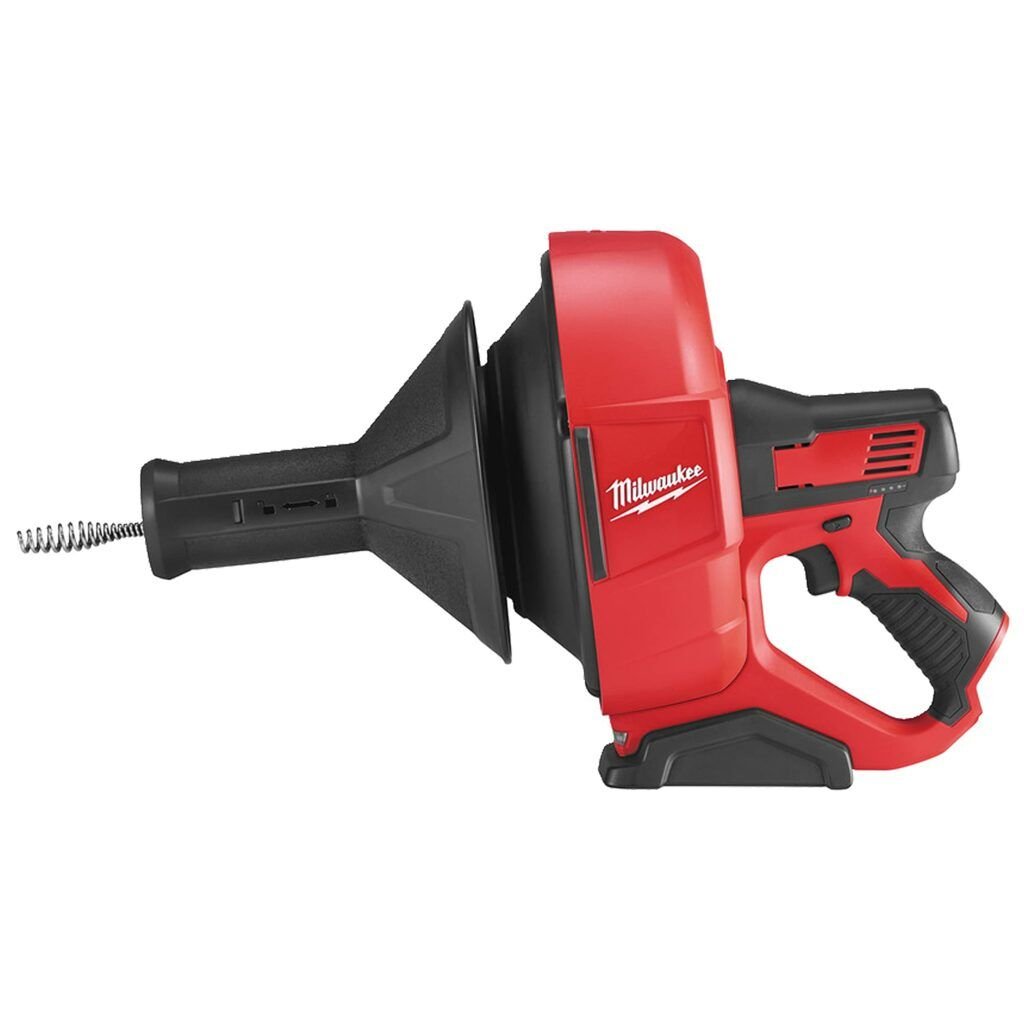
Tips on Mechanical Cleaners
What not to Do
How to properly use a drain snake:
Insert the Cable
Slowly feed the cable into the pipe, holding the machine in one hand and with decent gloves, hold the business end against the pipe.
Spin it Up
Spin the machine and feed the cable through gently, applying a bit more pressure against any bends and push until you feel resistance.
Let it Work it
When you think you’ve hit the blockage, keep it spinning and let the machine work its way through it.
Pull Back
Do not reverse the cable if it’s battery or mains operated. In forward, bring the cable back and stop spinning before it comes back to you.
Clean the Cable and Test
Remove any debris on the end of the cable, and clean the cable itself. Hopefully you’ve brought the blockage back with you, or you’ve at least punched a hole through it.
Some Mistakes to Avoid with a Mechanical Cleaner
Not Bothering with PPE
This is so easily overlooked but carries a lot of risk if neglected. For the sake of sticking gloves on and something to cover your eyes, you might save an eye or mangled hand.
Forcing the Cable
Drain snakes and mechanical cleaners are versatile but can break if pushed too hard. Let it work for you!
Not Assessing Bends
It’s important to check, as much as you can, how the blocked pipe flows to the next section. Most machines cannot cope with multiple sharp bends, especially if close together.
Not thoroughly Testing
It could take several attempts to clear the blockage, and sometimes the blockage can move down to the next bend or flat bit of pipe. Make sure you thoroughly test what you’re trying to clear after! Some blockages can be a singular mass and others may be a restriction for the majority of the pipe.
Not all drain snakes or mechanical cleaners are the same and there could be some differences in how to operate them, so make sure you familiarise yourself with whatever you choose to use.
Final Checks
After all this, hopefully you’ve managed to clear the blockage. Now just keep an eye out for any leaks where you took apart pipe connections or rodding access caps.
Now, assuming that all joints and seals are intact, keep that water flowing!
If there are any remnants or stubborn bits of blockage left in the pipe, constant water should dislodge it since it’s been disturbed and broken up.
By following these steps, you can hopefully clear many common types of blockages in your bath drain manually without having to buy expensive tools or calling someone out.
You May Also Like
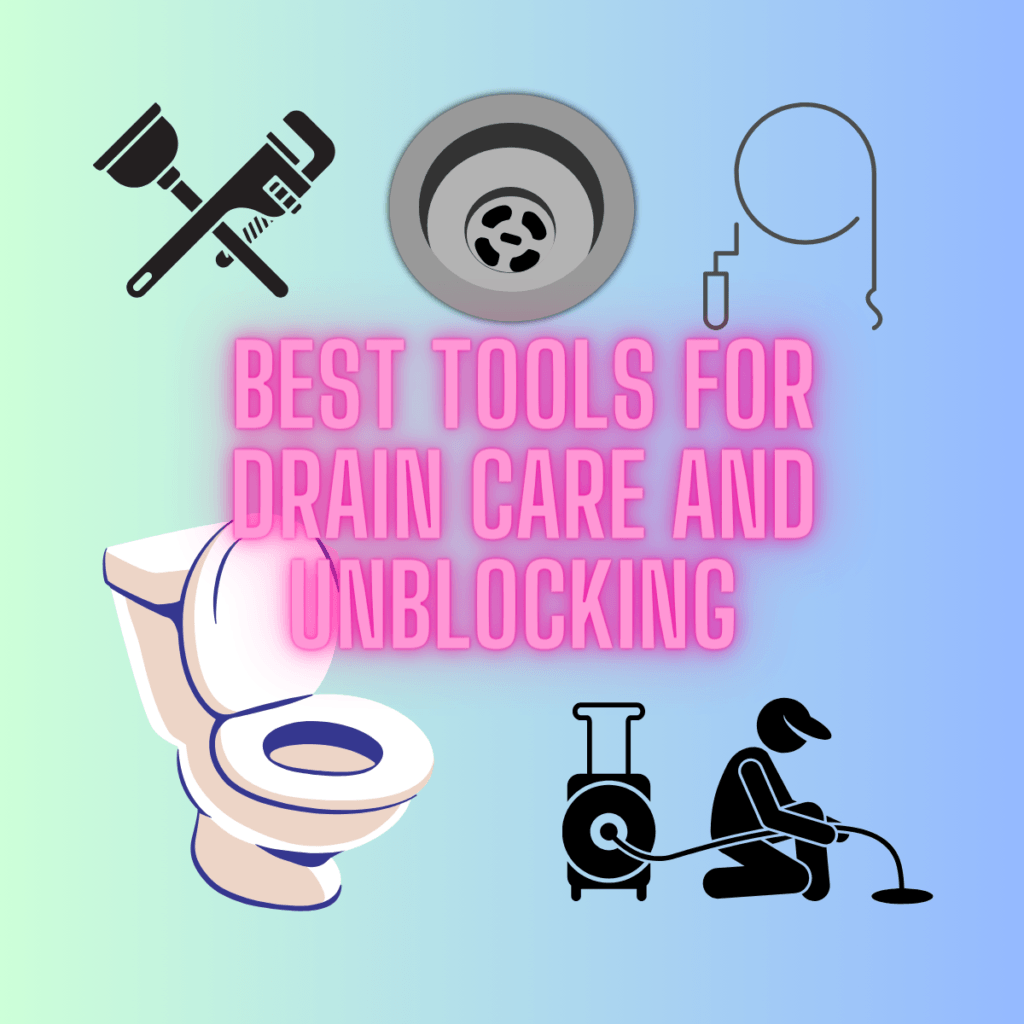
Best Tools for Drain Care & Unblocking
For more on generally clearing drains, click below!
Bath Drain Maintenance
Once you’ve unblocked the bath, keeping it clear with simple maintenance should prevent another emergency.
- Regular Drain Cleaning
Making a habit of a weekly drain clean, or whenever you happen to be cleaning the bathroom, remove any visible debris or objects such as hair or obstructions in the plughole.
- Natural Drain Cleaners
Use a mixture of baking soda and vinegar monthly to help dissolve any hidden build ups. The reason this wasn’t included in the unblocking methods above was because I don’t think this is a viable way of unblocking a stubborn blockage, especially if it’s further down the line.
But it’s perfectly fine for keeping the blockages from building up in the first place!
- Hot Water
The easiest and cheapest way to keep your bath clear is to simply run hot water through every so often, softening any debris and pushing it through. - Sani Sticks
These little enzyme sticks work on any sink or bath, but not all showers depending on the trap design. But for baths, they help keep your bath drain clear and fresh.
Once stick a month to keep your sinks healthy and smelling fresh!
- 12 months per package (1 stick per drain per month)
- Easy to use
- Reduces odours
- Safe for Septic Tanks

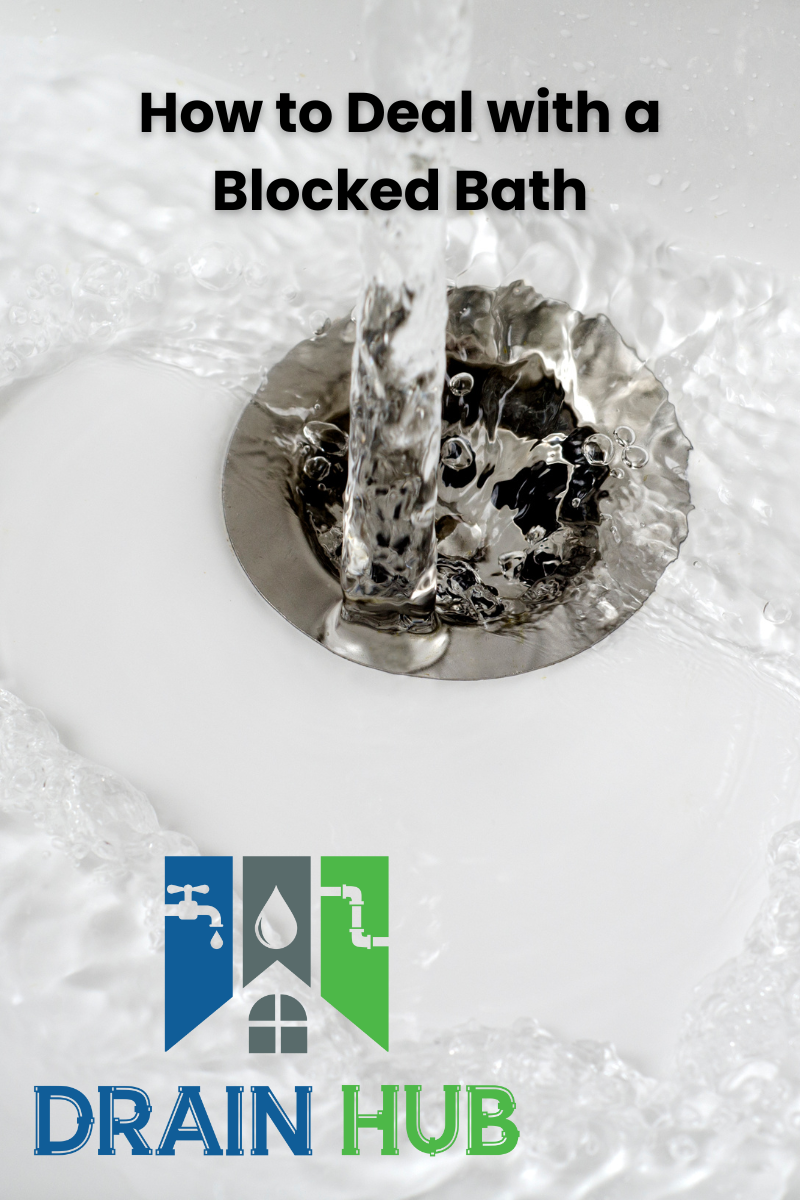
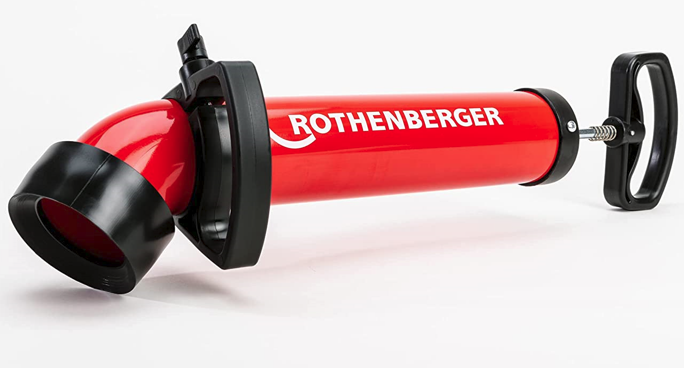

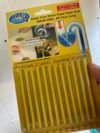
Leave a Reply